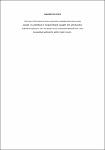Islamic Tradition and Innovation in a Contemporary Kuwaiti Woman’s Painting Practice
| dc.contributor.supervisor | Parker, Kayla | |
| dc.contributor.author | Almehana, Shaikha | |
| dc.contributor.other | School of Art, Design and Architecture | en_US |
| dc.date.accessioned | 2023-07-25T08:05:25Z | |
| dc.date.available | 2023-07-25T08:05:25Z | |
| dc.date.issued | 2023 | |
| dc.identifier | 10623397 | en_US |
| dc.identifier.uri | https://pearl.plymouth.ac.uk/handle/10026.1/21068 | |
| dc.description.abstract |
The thesis maps the ‘awakening’ of the author’s artistic practice and her identity as a female Arab Muslim painter through her studio-based research into Rumi’s writings, in conjunction with study of the Qur’an and Islamic teachings, informed by feminist ideas and enhanced by knowledge of the socio-political histories and cultures of Kuwait and the Arabian Gulf. This practice-led research project considers the role of the woman and the female artist in contemporary Kuwait by exploring new contexts for, and approaches to, contemporary painting in that country and the Middle East. Kuwait has sought to find a coherent and progressive cultural identity since the two Gulf Wars (1990–91, 2003–11). This project contributes to the development of that new identity by proposing a fusion of traditional and contemporary considerations, leading to an experimental, propositional body of work developed through theoretical and contextual investigation. The theoretical research considers and reinterprets specific traditional cultural practices of the Middle East, in particular Persian painting and the Sufi poetry of Rumi, to provide grounding references relevant to a painting practice. The research considers also the impact of feminism upon female thinkers and artists, both in the West and the Middle East, in order to provide a perspective on gender politics in Kuwait. This thesis thereby outlines a pathway for a contemporary female Kuwaiti artist to enter cultural, aesthetic, religious and political dialogue with her immediate cultural environment and her artistic and academic peers in Kuwait and beyond. The paintings that emerged through studio-based practice generated a method of performative mark-making that uses a personal iconography of abstracted and symbolic imagery of Arabic calligraphy and pictorial expression. The body of work, the practice component and the written exposition, combines, in both method and subject matter, Islamic and Western traditions, to formulate a dynamic self-contained dialogue, yet one also underpinned by an understanding of key components that both traditions have to offer a global cultural arena. This thesis, therefore, creates new knowledge through charting the author’s journey of awakening and evolution of an innovative visual language within the emergent field of painting by contemporary Arab women artists, in particular those of her home country, Kuwait. | en_US |
| dc.language.iso | en | |
| dc.publisher | University of Plymouth | |
| dc.rights | CC0 1.0 Universal | * |
| dc.rights.uri | http://creativecommons.org/publicdomain/zero/1.0/ | * |
| dc.subject.classification | PhD | en_US |
| dc.title | Islamic Tradition and Innovation in a Contemporary Kuwaiti Woman’s Painting Practice | en_US |
| dc.type | Thesis | |
| plymouth.version | publishable | en_US |
| dc.identifier.doi | http://dx.doi.org/10.24382/5074 | |
| dc.identifier.doi | http://dx.doi.org/10.24382/5074 | |
| dc.rights.embargoperiod | No embargo | en_US |
| dc.type.qualification | Doctorate | en_US |
| rioxxterms.version | NA |
Files in this item
This item appears in the following Collection(s)
-
01 Research Theses Main Collection
Research Theses Main



